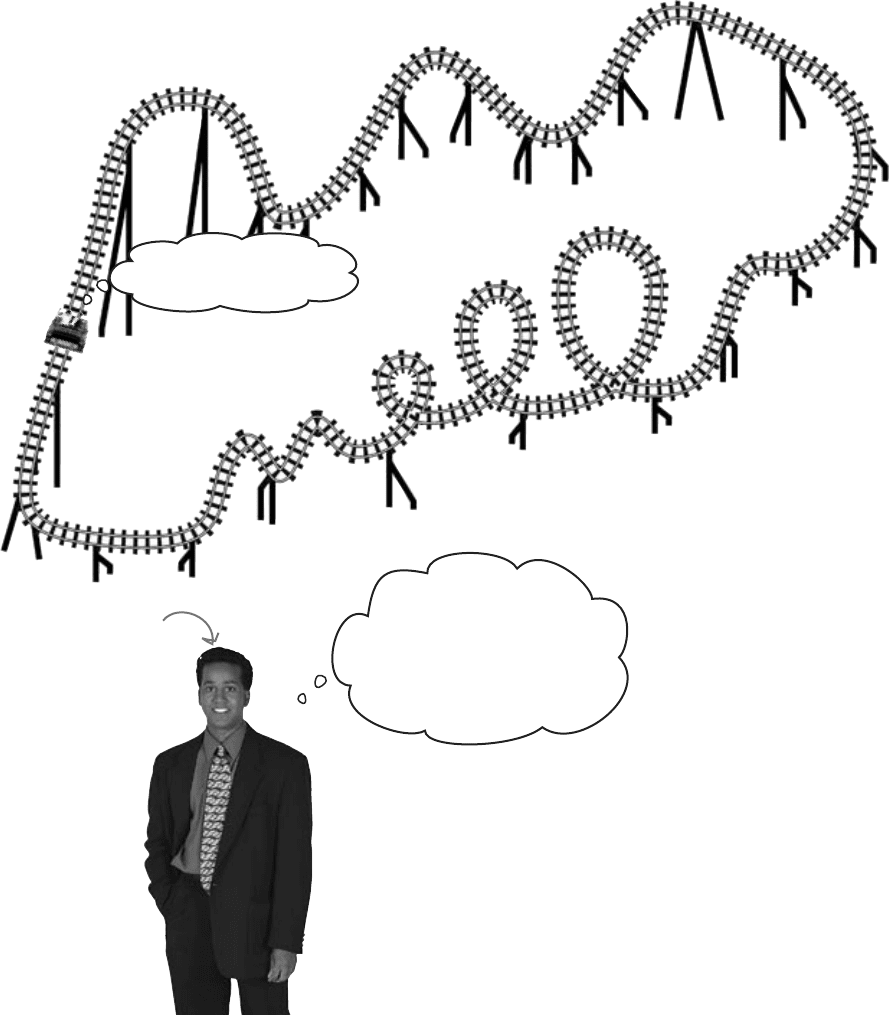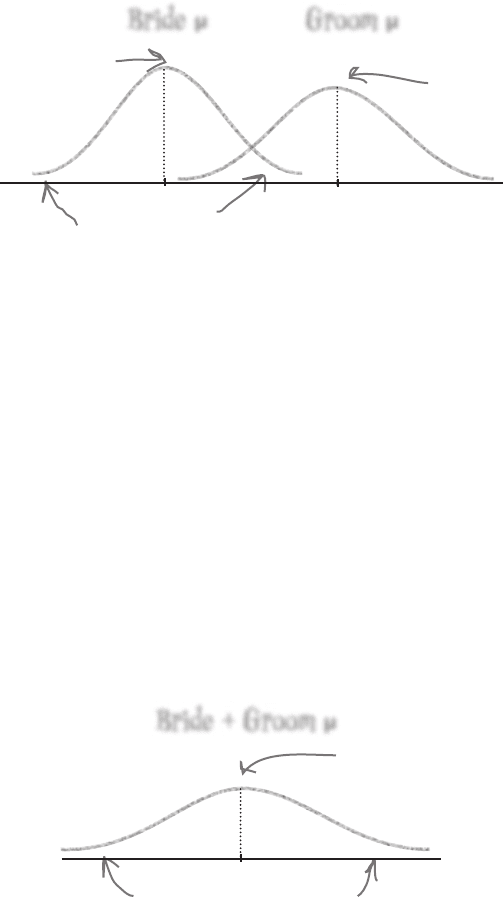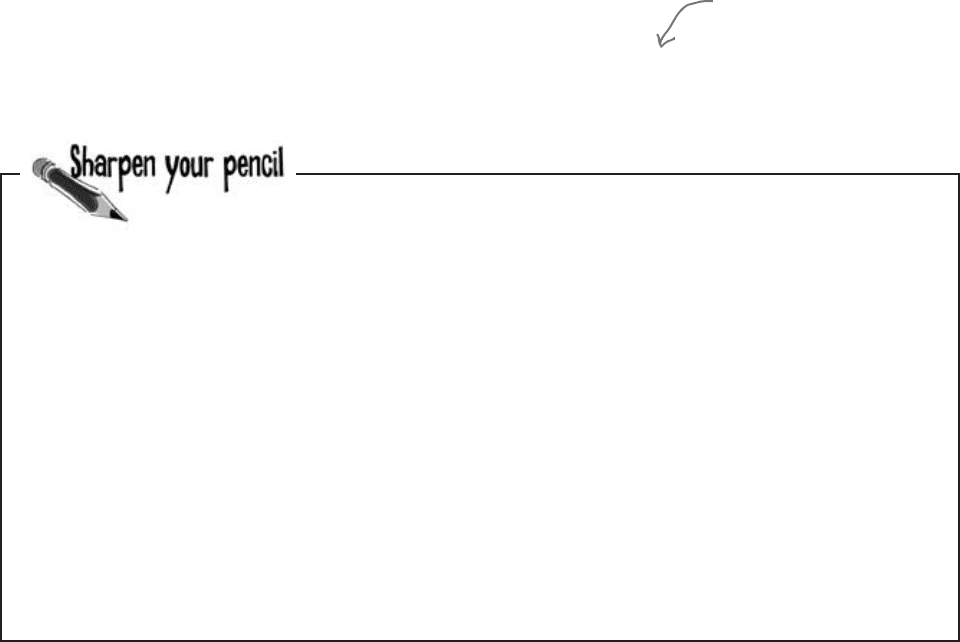Griffiths D. Head First Statistics
Подождите немного. Документ загружается.


this is a new chapter 361
using the normal distribution ii
9
Beyond Normal
If only all probability distributions were normal.
Life can be so much simpler with the normal distribution. Why spend all your time
working out individual probablities when you can look up entire ranges in one swoop, and
still leave time for game play? In this chapter, you’ll see how to solve more complex
problems in the blink of an eye, and you’ll also find out how to bring some of that normal
goodness to other probability distributions.
If only all probability distributions were normal.
Life can be so much simpler with the normal distribution. Why spend all your time
working out individual probablities when you can look up entire ranges in one swoop, and
still leave time for game play? In this chapter, you’ll see how to solve more complex
problems in the blink of an eye, and you’ll also find out how to bring some of that normal
goodness to other probability distributions.

362 Chapter 9
Love is a roller coaster
The wedding market is big business nowadays, and Dexter has an idea for
making that special day truly memorable. Why get married on the ground when
you can get married on a roller coaster?
Dexter’s convinced there’s a lot of money to be made from his innovative Love
Train ride, if only it passes the health and safety regulations.
Before Dexter can go any further, he needs to make
sure that his special ride can cope with the weight
of the bride and groom, and he’s asked if you can
help him.
The ride he has in mind can cope with combined weights of up to 380
pounds. What’s the probability that the combined weight will be less
than this?
I need to make sure
the combined weight of
the bride and groom won’t
be above 380 pounds.
Think you can help?
I dooooOOOooooo!
Dexter
come on, ride the love train

you are here 4 363
using the normal distribution ii
All aboard the Love Train
Before we start, we need to know how the weights of brides and grooms in
Statsville are distributed, taking into account the weight of all their wedding
clothes. Both follow a normal distribution, with the bride weight distributed
as N(150, 400) and the groom weight as N(190, 500). Their weights are
measured in pounds.
How do you think we can find the probability
distribution for the combined weights of the bride and
groom? What sort of distribution do you think this
might be? Why?
We need to use these two probability distributions to somehow work out
the probability that the weight of a bride and groom will be less than the
maximum weight allowance on the ride. If the probability is sufficiently
high, we can be confident the ride is feasible.
We can calculate
this probability if we
know what the combined
probability distribution is,
but what’s that?
Bride ~ N(150, 400)
150
Groom ~ N(190, 500)
190

364 Chapter 9
Normal bride + normal groom
Let’s start by taking a closer look at how the weights of the bride and groom
are distriuted.
As you know, the weights follow normal distributions like this:
Most brides will have
a weight around here
And most grooms
will have a weight
close to here.
Brides can be lighter or
heavier than the mean, and
this applies to the grooms too.
What we’re really after, though, is the probability distribution of the
combined weight of the bride and groom. In other words, we want to find
the probability distribution of the weight of the bride added to the weight
of the groom.
Bride weight + Groom weight ~ ?
Assuming the weights of the bride and groom are independent, the
shape of the distribution should look something like this:
Most couples will have
a joint weight around
here.
There’s a lot of variation in
combined weight, though.
150
190
Bride μ Groom μ
Bride + Groom μ
µ
adding two normal distributions

you are here 4 365
using the normal distribution ii
It’s time for a trip down memory lane. Can you remember the
discrete shortcuts for the following formulas? Assume X and Y are
independent.
1. E(X + Y)
3. E(X - Y)
2. Var(X + Y)
4. Var(X - Y)
It’s still just weight
Can you remember when we first looked at continuous data and looked at how data
such as height and weight tend to be distributed? We found that data such as height
and weight are continuous, and they also tend to follow a normal distribution.
This time we’re looking at the combined weight of the happy couple. Even though
it’s combined weight, it’s still just weight, and we already know how weight tends to be
distributed. The combined weight is still continuous. What’s more, the combined
weight is still distributed normally. In other words, the combined weight of the
bride and groom follows a normal distribution.
Knowing that the combined weight of the bride and groom follows a normal
distribution helps us a lot. It means that we’ll be able to use probability tables just
like we did before to look up probabilities, which means we’ll be able to look up the
probability that the combined weight is less than 380 pounds—just what we need for
the ride.
There’s only one problem—before we can go any further, we need to know the mean
and variance of the combined weight of the bride and groom. How can we find this?
Bride weight + Groom weight ~ N(?, ?)
The combined weight
of the bride and
groom follows a normal
distribution, but what’s
the mean and variance?

366 Chapter 9
It’s time for a trip down memory lane. Can you remember the
discrete shortcuts for the following formulas? Assume X and Y are
independent.
I don’t see how these
shortcuts help us. They’re
for discrete data, and we’re
dealing with continuous now.
The shortcuts apply to continuous data too.
When we originally encountered these shortcuts, we were dealing with discrete data.
Fortunately, the same rules and shortcuts also apply to continuous data.
1. E(X + Y)
3. E(X - Y)
2. Var(X + Y)
4. Var(X - Y)
E(X + Y) = E(X) + E(Y)
E(X - Y) = E(X) - E(Y)
Var(X + Y) = Var(X) + Var(Y)
Var(X + Y) = Var(X) + Var(Y)
Remember that we
ADD the variances, even
though it’s for X - Y.
How do you think we can use these shortcuts to find the probability
distribution of the weight of the bride + the weight of the groom?
sharpen solution

you are here 4 367
using the normal distribution ii
How’s the combined weight distributed?
So far, we’ve found that the combined weight of the bride and groom are
normally distributed, and this means we can use probability tables to look up
the probability of the combined weight being less than a certain amount.
Let’s try rewriting the bride and groom weight distributions in terms of X
and Y. If X represents the weight of the bride and Y the weight of the groom,
and X and Y are independent, then we want to find μ and σ where
X + Y ~ N(μ, σ
2
)
X + Y means “the weight of the bride + the
weight of the groom.” But how do we know
what the mean and variance are?
In other words, before we go any further we need to find the mean and variance of
X + Y. But how?
Take a look at the answers to the last exercise. When we were working with discrete
probability distributions, we saw that as long as X and Y are independent we could
work out E(X + Y) and Var(X + Y) by using
E(X + Y) = E(X) + E(Y) and Var(X + Y) = Var(X) + Var(Y)
So if we know what the expectation and variance of X and Y are, we can use these
to work out the expectation and variance of X + Y.
That means that if we
know the distribution of X
and Y, we can figure out the
distribution of X + Y too.
We can use what we already know to figure out
what we don’t.
Because we know how the weight of the bride and the weight of the
groom are distributed, we can find the distribution of the combined
weight of the bride and groom.
Let’s look at this in more detail.

368 Chapter 9
X + Y Distribution Up Close
Being able to find the distribution of X + Y is useful if you’re working
with combinations of normal variables. If independent random variables
X and Y are normally distributed, then X + Y is normal too. What’s
more, you can use the mean and variance of X and Y to calculate the
distribution of X + Y.
To find the mean and variance of X + Y, you can use the same formulae
that we used for discrete probability distributions. In other words, if
X ~ N(μ
x
, σ
x
2
) and Y ~ N(μ
y
, σ
y
2
)
then
where
μ = μ
x
+ μ
y
σ
2
= σ
x
2
+ σ
y
2
X + Y ~ N(μ, σ
2
)
If you add the means of X and Y together,
you get the mean of X + Y. Similarly,
summing the variances of X and Y gives you
the variance of X + Y
In other words, the mean of X + Y is equal to the mean of X plus the
mean of Y, and the variance of X + Y is equal to the variance of X plus
the variance of Y.
Let’s look at a sketch of this. What do you notice about the variance of
X + Y?
The variance of X + Y is greater than the variance of X and also
greater than the variance of Y, which means that the curve of X + Y
is more elongated than either. This is true for any normal X and Y.
By adding the two variables together, you are in effect increasing the
amount of variability, and this elongates the shape of the distribution.
This in turn means that the shape of the distribution gets flatter so that
the total area under the curve is still 1.
Remember, two variables are
independent if they have no impact
on each other’s probabilities.
We can use these shortcuts if
X and Y are independent, which
makes life very easy indeed
X ~ N(μ
x
, σ
x
2
)
X + Y ~ N(μ
x
+
μ
y
, σ
x
2
+ σ
y
2
)
Y ~ N(μ
y
, σ
y
2
)
+
=
μ
x
μ
y
μ
x
+
μ
y
x + y and x – y in depth

you are here 4 369
using the normal distribution ii
where
Sometimes X + Y just won’t give you the sorts of probabilities you’re
after. If you need to find probabilities involving the difference between two
variables, you’ll need to use X - Y instead.
X - Y follows a normal distribution if X and Y are independent random
variables and are both normally distributed. This is exactly the same
criteria as for X + Y.
To find the mean and variance, we again use the same shortcuts that we
used for discrete probability distributions. If
X ~ N(μ
x
, σ
x
2
) and Y ~ N(μ
y
, σ
y
2
)
then
μ = μ
x
- μ
y
σ
2
= σ
x
2
+ σ
y
2
X - Y ~ N(μ, σ
2
)
In other words, the mean of X – Y is equal to the mean of Y subtracted
from the mean of X, and you find the variance of X – Y by adding the X
and Y variances together.
We ADD the variances together,
just like we did for discrete
probability distributions.
X ~ N(μ
x
, σ
x
2
)
X - Y ~ N(μ
x
-
μ
y
, σ
x
2
+ σ
y
2
)
Y ~ N(μ
y
, σ
y
2
)
– =
Subtract the mean,
add the variance.
Adding the variances together may not make intuitive sense at first,
but it’s exactly the same as when we worked with discrete probability
distributions. Even though we’re subtracting Y from X, we’re actually
still increasing the amount of variability. Adding the variances together
reflects this. As with the X + Y distribution, this leads to a flatter, more
elongated shape than either X or Y
If you look at the actual shape of the X - Y distribution, it’s the same
shape curve as for X + Y distribution, except that the center has moved.
The two distributions have the same variances, but different means.
Look at the shape. It’s the same
shape as for X + Y but with the
center of the curve in a different
place. They have the same shape
because they have the same variance.
X – Y Distribution Up Close
μ
x
μ
y
μ
x
-
μ
y

370 Chapter 9
Q:
Remind me, why did we need to
find the distribution of X + Y?
A: We’re looking for the probability that
the combined weight of a bride and groom
will be less than 380 pounds, which means
we need to know how the combined weight
is distributed. We’re using X to represent the
weight of the bride, and Y to represent the
weight of the groom, which means we need
to use the distribution of X + Y.
Q:
You say we can look up
probabilities for X + Y using probability
tables. How?
A: In exactly the same way as we did
before. We take our probability distribution,
calculate the standard score, and then look
this value up in probablity tables.
Looking up probabilities for X + Y is no
different from looking up probabilities for
anything else. Just find the standard score,
look it up, and that gives you your probability.
Q:
So do all of the shortcuts we
learned for discrete data apply to
continuous data too?
A: Yes, they do. This means we have an
easy way of combining random variables
and finding out how they’re distributed,
which in turn means we can solve more
complex problems.
The key thing to remember is that these
shortcuts apply as long as the random
variables are independent.
Q:
Can you remind me what
independent means?
A: If two variables are independent, then
their probabilities are not affected by each
other. In our case, we’re assuming that the
weight of the bride is not influenced by the
weight of the groom.
Q:
What if X and Y aren’t independent?
What then?
A: If X and Y aren’t independent, then
we can’t use these shortcuts. We’d need to
do a lot more work to find out how X + Y is
distributed because you’d have to find out
what the relationship is between X and Y.
Finding probabilities
Now that we know how to calculate the distribution of X + Y, we
can look at how to use it to calculate probabilities. Here are the
steps you need to go through.
Work out the distribution and range
Standardize it
Look up the probabilities
Sound familiar? These are exactly the same steps that
we went through in the previous chapter for the normal
distribution.
We know we need to use X + Y, and
we have a way of working out the
mean and variance.
Once we know the distribution
and the range, we standardize it.
We can then look up the
probability in standard
normal probability tables.
calculating probabilities for x + y
1
3
2
